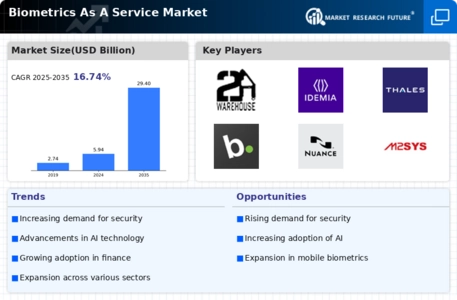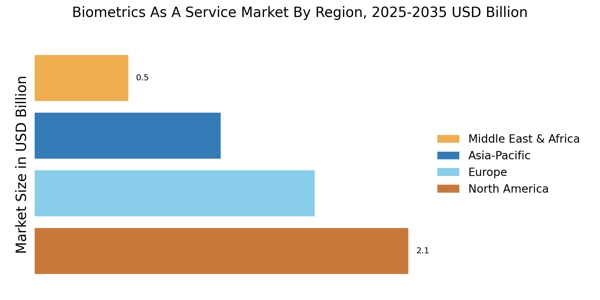Increasing Cybersecurity Threats
The rise in cybersecurity threats has propelled the Biometrics As A Service Market to the forefront of security solutions. Organizations are increasingly recognizing the inadequacy of traditional security measures, which often fail to protect sensitive data. As a result, the demand for biometric solutions, which offer advanced authentication methods, is surging. According to recent estimates, the biometrics market is projected to reach a valuation of approximately 30 billion dollars by 2026, indicating a robust growth trajectory. This trend suggests that businesses are prioritizing the implementation of biometric systems to safeguard their assets and maintain customer trust. The Biometrics As A Service Market is thus positioned to benefit from this heightened focus on security, as organizations seek to mitigate risks associated with data breaches and identity theft.
Growing Adoption of Mobile Devices
The proliferation of mobile devices has significantly influenced the Biometrics As A Service Market. With the increasing reliance on smartphones and tablets for various transactions, the need for secure authentication methods has become paramount. Biometric technologies, such as fingerprint and facial recognition, are being integrated into mobile applications to enhance user experience while ensuring security. Reports indicate that the mobile biometrics market is expected to grow at a compound annual growth rate of over 20% in the coming years. This trend underscores the potential for the Biometrics As A Service Market to expand as more businesses adopt mobile solutions that incorporate biometric authentication, thereby streamlining processes and improving security.
Regulatory Pressures and Compliance
Regulatory pressures are driving the Biometrics As A Service Market as organizations strive to comply with stringent data protection laws. Governments worldwide are implementing regulations that mandate enhanced security measures to protect personal information. For instance, the General Data Protection Regulation (GDPR) in Europe has set high standards for data privacy, compelling businesses to adopt biometric solutions that ensure compliance. This regulatory landscape is likely to fuel the demand for biometric services, as companies seek to avoid hefty fines and reputational damage associated with non-compliance. The Biometrics As A Service Market is thus expected to see increased investment as organizations prioritize compliance and security in their operational strategies.
Rising Consumer Awareness of Privacy Issues
Consumer awareness regarding privacy issues is influencing the Biometrics As A Service Market. As individuals become more informed about data security and privacy rights, they are demanding more secure authentication methods. Biometric solutions, which offer a higher level of security compared to traditional passwords, are increasingly being viewed as a viable alternative. Surveys indicate that a significant percentage of consumers prefer biometric authentication for its convenience and security features. This shift in consumer preference is likely to drive the adoption of biometric services across various sectors, including finance, healthcare, and retail. The Biometrics As A Service Market is thus poised to benefit from this growing awareness, as businesses respond to consumer demands for enhanced security and privacy.
Technological Advancements in Biometric Solutions
Technological advancements are reshaping the Biometrics As A Service Market, leading to more sophisticated and reliable biometric solutions. Innovations in artificial intelligence and machine learning are enhancing the accuracy and efficiency of biometric systems, making them more appealing to businesses. For instance, advancements in facial recognition technology have improved its effectiveness in various applications, from security to customer service. The market for biometric solutions is anticipated to grow significantly, with projections indicating a potential market size of over 40 billion dollars by 2027. This growth is indicative of the increasing reliance on advanced biometric technologies, which are becoming integral to security frameworks across industries. The Biometrics As A Service Market stands to gain from these technological developments, as organizations seek to leverage cutting-edge solutions.


















Leave a Comment